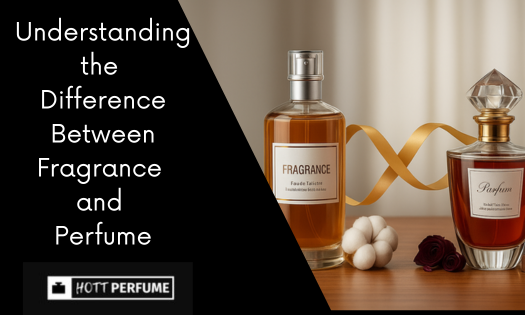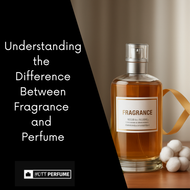Understanding the Difference Between Fragrance and Perfume
Posted by Tina Wilson on Nov 12th 2025

Introduction to Perfume and Fragrance
When you shop for a new scent, the terms perfume and fragrance are often used interchangeably, highlighting the difference between perfume and fragrance, but they refer to fundamentally different things.
Fragrance is the broad, umbrella term for any scented product, including everything from candles and lotions to body sprays and colognes, available in various concentrations, including much lower fragrance concentrations.
Perfume (or Parfum), however, is the most concentrated form of fragrance, representing a specific, highly concentrated type. Perfumes contain the highest percentage of aromatic oils, giving them a much richer scent and the longest wear time compared to any other fragrance product.
What Is a Fragrance?
Fragrance is the general, all-encompassing term used to describe any product that carries a pleasant smell or scent, often derived from aromatic compounds. Think of it as the ultimate umbrella category for aromatic products.
Where You Find Fragrance
Fragrance is not limited to personal body sprays; it also includes various household products and everyday products that are especially popular during the warmer months, often with lower fragrance concentration. It's a vital component designed to enhance the sensory appeal of a vast array of goods, including fragrance oils, contributing to their pleasant scents:
-
Personal Care: Lotions, soaps, cosmetics, and skincare products.
-
Personal Scent: Perfumes, colognes, and body mists.
-
Home Goods: Candles, air fresheners, laundry detergents, and cleaning supplies.
The Composition
A fragrance is created through a complex formulation of several key ingredients, typical of various fragrance types, working in harmony:
-
Aroma Compounds: These include essential oils (natural extracts) and aroma chemicals (synthetic compounds) that provide the actual smell.
-
Fixatives: Ingredients that help the aromatic compounds linger and maintain their character, increasing the scent's longevity.
-
Solvents: Typically, alcohol (ethanol) or oils, which dilute the concentrated aromatic compounds, making them sprayable and usable.
Depending on how these components are blended and diluted, a fragrance can be light and refreshing (like a body mist) or deep and long-lasting (like a perfume).
What Is a Perfume?
A Perfume (or Parfum) is the gold standard within the broader fragrance family. It is defined by its high concentration of aromatic oils, which delivers the richest, deepest scent profile and the longest wear time compared to any other form. These are carefully crafted blends of essential oils, aroma compounds, and a high-grade alcohol base, ensuring a robust scent.
Understanding Scent Concentration Levels
Perfumes and personal fragrances are categorized based on the percentage of aromatic oil concentration within the blend, often with perfume being the most expensive form. The higher the oil concentration, the more intense and long-lasting the scent will be:
|
Category |
Aromatic Oil |
Wear Time |
Best For |
|
Parfum (Extrait) |
20% to 30% |
6 to 8+ hours |
Highest intensity; evening or special occasions. |
|
Eau de Parfum (EDP) |
15% to 20% |
4 to 5 hours |
Strong, versatile; ideal for everyday wear or work. |
|
Eau de Toilette (EDT) |
5% to 15% |
2 to 3 hours |
Fresher, more subtle; good for office or warm weather. |
|
Eau de Cologne (EDC) |
2% to 5% |
1 to 2 hours |
Light and crisp; traditional men's fragrance or quick refresh. |
|
Body Mist/Splash |
1% to 3% |
Less than 1 hour |
Most diluted, quick refresher, or for layering scents. |
Choosing your scent strength based on this hierarchy, fragrance types like Parfum being the strongest and Mist being the lightest, allows you to perfectly match the product to the occasion and your desired lasting scent.
Mastering Perfume: A Practical Guide to Fragrance Types
Types of Fragrances: Choosing Your Scent Strength
While Fragrance is the general term and Perfume is the most concentrated type, the world of personal scent is organized by several specific concentration levels, each offering a unique smell. Choosing the right one depends on your desired longevity and the occasion:
|
Category |
Characteristic Use |
Scent Profile & Purpose |
|
Eau de Parfum (EDP) |
Rich scent with strong lasting power (4-5 hours). |
Ideal for evening wear, events, or when you want your scent to be consistently noticeable. |
|
Eau de Toilette (EDT) |
Lighter and more refreshing than EDP (2-3 hours). |
Excellent for daily wear, office settings, and warm weather when a subtle projection is preferred. |
|
Eau de Cologne (EDC) |
Crisp, invigorating scent that fades quickly (1-2 hours). |
Often used as a quick, refreshing splash after showering or for a light, traditional daytime scent. |
|
Eau Fraiche |
The most diluted option, offering the subtlest trace of scent. |
Best for those who prefer an extremely light, airy hint of fragrance, or for high-heat environments. |
Classification by Scent Family
Beyond concentration, fragrances are also classified by their Scent Family, which helps individuals choose scents that match their mood or personality:
-
Citrus: Zesty, uplifting, and fresh (Lemon, Bergamot).
-
Floral: Romantic and sweet (Rose, Jasmine, Gardenia).
-
Woody: Warm, deep, and earthy (Sandalwood, Cedar, Patchouli).
-
Amber: Rich, warm, and often spicy/sweet (Vanilla, Incense).
-
Fresh: Clean, airy, and sometimes aquatic (Sea Salt, Green Tea).
Concentrations of Perfume
Perfume concentration is the single most important factor determining a scent's strength and wear time. It refers to the percentage of highly valuable aromatic oils dissolved in an alcohol base. Simply put: The higher the concentration, the richer and longer-lasting the scent will be.
The Most Concentrated Categories
The top two tiers, often with an oil base, offer the deepest complexity and maximum longevity:
-
Parfum (Extrait de Parfum):
-
Concentration: 20% to 30% aromatic oils.
-
Wear Experience: This is the most concentrated and luxurious form. It sits closest to the skin, providing a deep, complex scent that lasts the longest.
-
Longevity: Can last 8 to 12+ hours.
-
-
Eau de Parfum (EDP):
-
Concentration: 15% to 20% aromatic oils.
-
Wear Experience: Slightly lighter than Parfum, but still rich and noticeable. It provides a strong scent trail without being overpowering.
-
Longevity: Typically lasts 6 to 8 hours.
-
A higher concentration means a more intense scent that evolves slowly over time, making Parfum and Eau de Parfum ideal for long events, evening wear, or when you want your scent to make a lasting impression.
Other Perfume Concentrations
While Parfum and Eau de Parfum are for intensity, these lower concentrations are designed for daily use, warm weather, and quick refreshment. They offer a lighter scent experience that requires more frequent reapplication.
-
Eau de Toilette (EDT):
-
Concentration: 5%–15% aromatic oils.
-
Purpose: The popular everyday standard. It's light, versatile, and provides enough presence for the office or daytime wear without being overwhelming.
-
Wear Time: Typically lasts 3–4 hours.
-
-
Eau de Cologne (EDC):
-
Concentration: 2%–5% aromatic oils.
-
Purpose: Traditionally features crisp, citrusy, and invigorating notes. It's designed for a generous application and a quick, refreshing splash.
-
Wear Time: Typically lasts 1–2 hours.
-
-
Eau Fraiche:
-
Concentration: 1%–3% aromatic oils.
-
Purpose: The most diluted option, often water-based. It offers a subtle, cooling aroma—perfect for very hot weather or an immediate post-workout freshness.
-
Wear Time: Less than 1 hour (designed to be very fleeting).
-
Each concentration serves a distinct purpose, allowing you to easily select a fragrance that perfectly matches the desired strength, longevity, and occasion in your lifestyle, while still offering only a couple of distinct smells.
Key Differences Between Fragrance and Perfume
The simple rule to remember is: All perfumes are fragrances, but not all fragrances are perfumes, so choosing the perfect scent can sometimes be a challenge. Fragrance is the broad category; perfume is the highly concentrated specific.
Here is a quick comparison to make the distinction clear:
|
Feature |
Fragrance (General Term) |
Perfume (Parfum or Extrait) |
|
Definition |
A broad term for any scented product (mists, candles, lotions, colognes, perfumes, etc.). |
A specific, highly concentrated type of fragrance designed for maximum wear. |
|
Aromatic Oil Concentration |
Varies widely (typically 1% to 20%) depending on the product type (EDC, EDT, Mist). |
Highest concentration (typically 15% to 30%) of aromatic oils. |
|
Scent Strength |
Light to moderate (fades quickly). |
Strong, rich, intense, and complex. |
|
Longevity (Wear Time) |
Usually lasts 1 to 4 hours. |
It can last 6 to 12 hours or more. |
|
Price Range |
More affordable, as it uses more solvent (alcohol/water). |
Typically more expensive due to the high volume of aromatic oils. |
|
Common Use |
Everyday items (lotions, body sprays), ambient home scents. |
Statement scent, luxury item, evening wear, or special occasions. |
Factors to Consider When Choosing a Fragrance
Choosing the right fragrance, whether it be perfumes or colognes, is a deeply personal experience. What smells amazing to one person might not work the same way for you. To find your perfect signature scent, keep these key factors in mind:
1. Your Skin Type & Chemistry
Fragrance interacts uniquely with individual skin chemistry, dramatically affecting wear time:
-
Oily Skin: Tends to hold scent longer, making lighter concentrations (like EDT) more suitable for all-day wear.
-
Dry Skin: May cause fragrances to fade faster. Opt for richer concentrations (Parfum or EDP) or apply to well-moisturized skin.
-
Sensitive Skin: It is best to choose perfumes with natural ingredients or lower alcohol concentrations (like Parfum) to minimize the risk of irritation.
2. Personal Preferences & Scent Family
Your signature scent should reflect your personality and lifestyle:
-
Lighter Profiles: Choose fresh, citrusy, or aquatic notes for an uplifting, clean feel.
-
Deeper Profiles: Choose warm, musky, amber, or woody notes for richness and sophistication.
-
Discovery: Sampling scents from different families is the only way to truly discover what suits your unique taste.
3. Occasion & Time of Day
Match the fragrance strength to the environment.
-
Daytime/Work: Lighter, more refreshing concentrations (EDT, EDC, or light EDP) are ideal to avoid overwhelming others in close settings.
-
Evening/Special Events: Deeper, richer notes (Amber, Vanilla, Wood) and higher concentrations (Parfum or strong EDP) are appropriate for making a lasting impression.
4. Longevity Needs
This factor directly determines your choice of concentration when selecting discount cologne for men, especially those with natural ingredients as opposed to pure perfume.
-
If you need a scent that lasts 6–12 hours, choose Perfume (Parfum) or Eau de Parfum (EDP).
-
For a softer, casual scent that lasts 2–4 hours, an Eau de Toilette (EDT) or Body Mist is the better, lighter choice.
How to Choose Between Fragrance and Perfume
The decision between a light fragrance and a highly concentrated perfume ultimately depends on your lifestyle, environment, and the specific way you want your scent to express itself.
|
Scenario |
Best Choice |
Why It Works |
|
Daily Wear / Workplace |
Body Mists or Eau de Toilette (EDT) |
These are light, refreshing, and affordable options. Their lower concentration is ideal for close quarters, office settings, and layering without becoming overwhelming. |
|
All-Day Longevity / Events |
Perfume (Parfum) or Eau de Parfum (EDP) |
Their high oil concentration is built to last 6 to 12 hours. They are perfect for date nights, formal events, or when you need a scent to maintain its depth from morning till night. |
|
Subtlety vs. Statement |
EDT/EDC (Subtle) vs. EDP/Parfum (Statement) |
Daytime settings call for subtlety; choose lighter, fresher notes. Evenings and social occasions allow for deeper, richer perfumes to make a bolder impression. |
Final Tip: Test Before You Commit to any splash on fragrance to ensure it matches your expectations.
Remember that fragrances evolve. What smells strong upon the first spray (the top notes) will settle into a softer, different scent (the base notes) after an hour. Always test the product on your skin and wait 30 minutes to ensure you love the final, lasting fragrance before buying.
Fragrance Options
The modern fragrance market offers a wide array of scented products, each crafted for a unique experience, purpose, and setting. The choice isn't just about concentration; it's about where and how you want the aroma to be enjoyed.
Personal Wear Options
These products are designed to be worn on the skin:
-
Perfumes (Parfum & EDP): These are rich, complex, and long-lasting, perfect for special occasions or when you need your scent to maintain a presence for 6+ hours.
-
Colognes & Eau de Toilette (EDT): Lighter, fresher, and generally less expensive. They are ideal for everyday wear, the office, or when you prefer a refreshing scent that is noticeable but not overwhelming.
-
Body Mists: Offer the softest, most subtle scent with minimal longevity. They are best used for a quick pick-me-up, a light layer after showering, or frequent reapplication throughout the day.
Home & Ambient Options
These products are designed to scent your environment:
-
Home Fragrances: This broad category includes candles, diffusers, room sprays, and linen sprays. They are formulated to bring pleasant, lasting aromas into your living space, enhancing mood and atmosphere.
Fragrances can be crafted from fragrance oils, natural essential oils from natural sources, synthetic aroma compounds, or a blend of both, giving perfumers endless room to create perfumes and for creativity.. Understanding how and where each product is enjoyed is the final step in making an informed choice, especially when considering the difference in fragrance types.
Top Fragrances to Buy: Affordable Options for Every Occasion
Perfume and Fragrance Products
Fragrance products come in a wide variety of physical forms, each offering a unique way to apply and wear your favorite scent. The method of application often influences the scent's immediate strength and projection.
Application Formats
-
Sprays (Atomizers): The most common format, sprays provide a fine mist and even coverage, distributing the fragrance across a wider area of the skin or clothing for maximum diffusion.
-
Roll-ons (Roll-on Oils): Ideal for highly concentrated oils or for quick, on-the-go touch-ups. Roll-ons place the scent directly onto pulse points (like wrists or neck) for precise application and intimate projection.
-
Splash-ons: Offer a classic, old-school experience. These are typically found in lighter concentrations (like EDC) and are meant to be liberally applied or splashed onto the skin for an immediate, refreshing boost.
Categorization and Use
Fragrance products are typically categorized by:
-
Concentration Level: (Parfum, EDP, EDT), which determines longevity.
-
Scent Family: (Floral, Woody, Citrus), which defines the aroma.
-
Intended Use: (Personal wear vs. ambient)
Beyond personal use, fragrances elevate your surroundings: even oilier products like scented candles, diffusers, and room sprays add warmth, personality, and sensory appeal to any space, completing the overall fragrance experience.
Creating Perfume Products
The creation of perfume is a fascinating blend of art and science. It requires a deep understanding of fragrance oils, aroma compounds, and the composition of pure perfume, allowing perfumers to craft balanced and memorable blends that evoke emotion.
Perfume makers rely on both organic compounds, including natural essential oils, and high-quality synthetic ingredients to achieve depth, longevity, and creative control. A well-crafted perfume tells a story that unfolds over time, known as the Scent Pyramid:
-
Top Notes: The initial impression. These are light, volatile molecules (often citrus or fresh scents) that you smell immediately but that fade quickly.
-
Middle Notes (Heart): The core of the fragrance. These emerge as the top notes fade, providing the main character of the scent (often floral or spicy notes).
-
Base Notes: The lasting foundation. These are rich, heavy molecules (like woods or amber) that linger longest, providing depth and anchoring the entire blend.
This balanced composition ensures the fragrance is not only pleasant at first spray but remains a cohesive and beautiful scent for hours.
Common Misconceptions
The world of scent is full of myths. Clearing up these common misconceptions, including the difference between fragrance and perfume, will help you shop smarter and choose the perfect product while understanding the word fragrance.
|
The Myth |
The Reality (The Fact) |
Your Takeaway |
|
"Perfumes are only for women." |
Fact: Fragrances are inherently gender-neutral. Many popular scent profiles (like citrus, musk, and amber) are marketed and enjoyed universally. |
Choose the scent you love, regardless of the label. |
|
"All fragrances last equally long." |
Fact: Longevity depends directly on concentration. A perfume (high oil content) is designed to last 6–12 hours, while a body mist lasts less than one hour. |
Match the concentration (EDP, EDT, etc.) to your wear-time needs. |
|
"Expensive perfumes always mean better quality." |
Fact: High prices often reflect brand reputation, marketing, or packaging, not always superior ingredients. |
Focus on how the scent develops on your skin, not the price tag. |
|
"Fragrance terms are identical everywhere." |
Fact: Terminology (EDP, EDT) can slightly vary by brand or region, but the core concept of oil concentration remains the key factor affecting performance. |
Understand the percentage of oil concentration—that is the reliable metric. |
Conclusion
In summary, the difference between perfume and fragrance lies not only in their concentration but also in their intensity, purpose, and personality, which may include elements from eau fraiche or citrus notes. Perfume is a concentrated form of fragrance designed to last, often made with natural materials. In contrast, fragrance serves as the broader category that includes everything from body mists to home scents.
Whether you prefer a bold, long-lasting statement in pure perfume or a soft, refreshing mist, knowing the concentrations ensures you pick the perfect product for every occasion.


